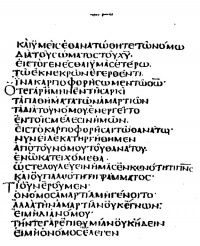Codex Claromontanus
From Textus Receptus
Codex Claromontanus, symbolized by Dp or 06 (in the Gregory-Aland numbering), δ 1026 (von Soden), is a Greek-Latin diglot uncial manuscript of the New Testament, written in an uncial hand on vellum. The Greek and Latin text on facing pages.[] The Latin text is designated by d (traditional system) or by 75 in Beuron system.
Contents |
Description
The codex contains the Pauline epistles on 533 leaves, Template:Convert by Template:Convert. The text is written in one column per page, 21 lines per page. The codex is dated palaeographically to the 5th or 6th century.[]
The Codex Claromontanus contains further precious documents:
- A stichometric catalogue of the Old Testament and New Testament canon, of uncertain date, has been inserted in the codex. The list omits Philippians, 1 and 2 Thessalonians, and Hebrews. It includes several works no longer considered canonical: Epistle of Barnabas, The Shepherd of Hermas, Third Epistle to the Corinthians, Acts of Paul, and Revelation of Peter.[]
- Two palimpsest leaves (nos. 162 and 163) are overwritten on fragments of the Phaethon of Euripides, faintly legible under the Christian text. They have been detached from the codex and in the Bibliothèque National are designated Cod. Gr. 107 B.[][]
Text
The Greek text of this codex is highly valued by critics as representing an early form of the text in the Western text-type, characterized by frequent interpolations and, to a lesser extent, interpretive revisions presented as corrections to this text. Modern critical editions of the New Testament texts are produced by an eclectic method, where the preferred reading is determined on a case-by-case basis, from among numerous variants offered by the early manuscripts and versions. In this process, Claromontanus is often employed as a sort of "outside mediator" in collating the more closely related, that is mutually dependent, codices containing the Pauline epistles: Codex Alexandrinus, Codex Vaticanus, Codex Sinaiticus, and Codex Ephraemi Rescriptus. In a similar way, Codex Bezae Cantabrigiensis is used in establishing the history of texts of the Gospels and Acts. Kurt Aland the text of the codex placed in Category II.[]
The section 1 Cor 14:34-35 is placed after 1 Cor 14:40, just like other manuscripts of the Western text-type (Augiensis, Boernerianus, 88, itd, g, and some manuscripts of Vulgate).[][]
In Romans 1:8 it has textual variant περι (along with א A B C K 33 81 1506 1739 1881), but corrector changed into υπερ, as in G Ψ Byz.[]
thumb|right|200px|Epistle to the Colossians
History
The Codex is preserved at the Bibliothèque nationale de France (Gr. 107), at Paris.[] The order of the epistles to the Colossians and Philippians have exchanged places; the Epistle to the Hebrews follows after that to Philemon. The text is written colometrically.
It was named by the Calvinist scholar Theodore Beza because he procured it in the town of Clermont-en-Beauvaisis, Oise, in the Picardie region north of Paris. Beza was the first to examine it, and he included notes of some of its readings in his editions of the New Testament. The later history of its use by editors of the Greek New Testament can be found in the links and references.
The manuscript was examined by Johann Jakob Griesbach[] and Constantin von Tischendorf.
See also
- Codex Sangermanensis
- Uncial 0320
- List of New Testament uncials
- List of New Testament Latin manuscripts
- Textual criticism
References
Further reading
- W. H. P. Hatch, The Principal Uncial Manuscripts Of The New Testament, 1939, The University of Chicago Press, Chicago.
- Bruce M. Metzger, The Text Of The New Testament: Its Transmission, Corruption and Restoration, 1968 etc., Oxford University Press. pp. 49–51.
- Trobisch, David, The Oldest Extant Editions of the Letters of Paul 1999 (e-text online).
- Berschin, Walter, "Greek Manuscripts in Western Libraries" ch. 6 of Greek Letters and the Latin Middle Ages: From Jerome to Nicholas of Cusa: diglot mss in the West.
- F. C. Burkitt, On Codex Claromontanus (h), (JTS, London 1903), pp. 587–588.
External links
- Codex Claromontanus D (06): at the Encyclopedia of Textual Criticism
- Michael D. Marlowe, Bible Research: Codex Claromontanus
- Stichometric list in Codex Claromontanus (about A.D. 400): Catalogus Claromontanus
- Codex Bezae and Codex Claromontanus Template:Fr

